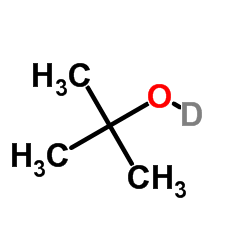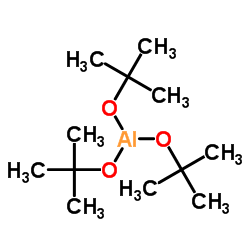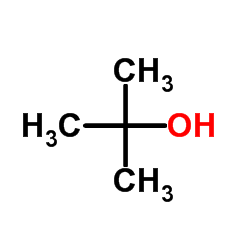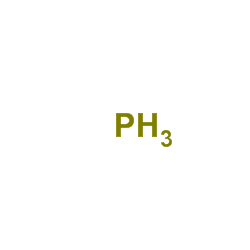3972-25-6
| Name | 2-deuteriooxy-2-methylpropane |
|---|---|
| Synonyms |
tert-butyl alcohol-d1
2-Propanol-d, 2-methyl- MFCD00044421 t-C4H9OD tert-Butyl alcohol-d tert-Butanol-OD 2-Methyl-2-propan(H)ol 2-Propanol-d,2-methyl EINECS 223-597-1 2-Methylpropan-2-(H)ol Tert-butyl Alcohol-OD 2-Propanol,2-methyl-d |
| Density | 0.8±0.1 g/cm3 |
|---|---|
| Boiling Point | 84.6±8.0 °C at 760 mmHg |
| Melting Point | 23-26ºC(lit.) |
| Molecular Formula | C4H9DO |
| Molecular Weight | 75.128 |
| Flash Point | 11.7±0.0 °C |
| Exact Mass | 75.079445 |
| PSA | 20.23000 |
| LogP | 0.51 |
| Vapour Pressure | 46.0±0.3 mmHg at 25°C |
| Index of Refraction | 1.395 |
| Storage condition | Flammables area |
Synonym:NoneNon Section 2 - COMPOSITION, INFORMATION ON INGREDIENTS
Risk Phrases: 11 20 Section 3 - HAZARDS IDENTIFICATION EMERGENCY OVERVIEW
Highly flammable. Harmful by inhalation.Hygroscopic (absorbs moisture from the air). Potential Health Effects Eye: May cause eye irritation. Skin: May cause mild skin irritation. May cause reddening of the skin. Ingestion: May cause irritation of the digestive tract. May cause central nervous system depression, characterized by excitement, followed by headache, dizziness, drowsiness, and nausea. Advanced stages may cause collapse, unconsciousness, coma and possible death due to respiratory failure. Inhalation: May cause respiratory tract irritation. May cause narcotic effects in high concentration. May cause drowsiness, unconsciousness, and central nervous system depression. Chronic: Chronic inhalation may cause effects similar to those of acute inhalation. Section 4 - FIRST AID MEASURES Eyes: Immediately flush eyes with plenty of water for at least 15 minutes, occasionally lifting the upper and lower eyelids. Get medical aid immediately. Skin: Immediately flush skin with plenty of water for at least 15 minutes while removing contaminated clothing and shoes. Get medical aid if irritation develops or persists. Ingestion: Call a poison control center. If swallowed, do not induce vomiting unless directed to do so by medical personnel. Never give anything by mouth to an unconscious person. Get medical aid. Inhalation: Get medical aid immediately. Remove from exposure and move to fresh air immediately. If not breathing, give artificial respiration. If breathing is difficult, give oxygen. Notes to Physician: Section 5 - FIRE FIGHTING MEASURES General Information: Containers can build up pressure if exposed to heat and/or fire. As in any fire, wear a self-contained breathing apparatus in pressure-demand, MSHA/NIOSH (approved or equivalent), and full protective gear. Vapors can travel to a source of ignition and flash back. During a fire, irritating and highly toxic gases may be generated by thermal decomposition or combustion. Flammable Liquid. Can release vapors that form explosive mixtures at temperatures above the flashpoint. Use water spray to keep fire-exposed containers cool. Extinguishing Media: Use foam, dry chemical, or carbon dioxide. Water may be ineffective. Section 6 - ACCIDENTAL RELEASE MEASURES General Information: Use proper personal protective equipment as indicated in Section 8. Spills/Leaks: Absorb spill with inert material (e.g. vermiculite, sand or earth), then place in suitable container. Remove all sources of ignition. Section 7 - HANDLING and STORAGE Handling: Wash thoroughly after handling. Use only in a well-ventilated area. Ground and bond containers when transferring material. Avoid contact with eyes, skin, and clothing. Empty containers retain product residue, (liquid and/or vapor), and can be dangerous. Keep container tightly closed. Keep away from heat, sparks and flame. Avoid ingestion and inhalation. Do not pressurize, cut, weld, braze, solder, drill, grind, or expose empty containers to heat, sparks or open flames. Storage: Keep away from heat, sparks, and flame. Keep away from sources of ignition. Store in a tightly closed container. Store in a cool, dry, well-ventilated area away from incompatible substances. Flammables-area. Section 8 - EXPOSURE CONTROLS, PERSONAL PROTECTION Engineering Controls: Use adequate general or local exhaust ventilation to keep airborne concentrations below the permissible exposure limits. Exposure Limits CAS# 3972-25-6: Personal Protective Equipment Eyes: Wear appropriate protective eyeglasses or chemical safety goggles as described by OSHA's eye and face protection regulations in 29 CFR 1910.133 or European Standard EN166. Skin: Wear appropriate protective gloves to prevent skin exposure. Clothing: Wear appropriate protective clothing to prevent skin exposure. Respirators: Follow the OSHA respirator regulations found in 29 CFR 1910.134 or European Standard EN 149. Use a NIOSH/MSHA or European Standard EN 149 approved respirator if exposure limits are exceeded or if irritation or other symptoms are experienced. Section 9 - PHYSICAL AND CHEMICAL PROPERTIES Physical State: Liquid Color: clear, colorless Odor: Not available. pH: Not available. Vapor Pressure: 40 mm Hg @24.5 Viscosity: Not available. Boiling Point: 83 deg C @ 760.00mm Hg Freezing/Melting Point: Not available. Autoignition Temperature: Not available. Flash Point: 11 deg C ( 51.80 deg F) Explosion Limits, lower: Not available. Explosion Limits, upper: Not available. Decomposition Temperature: Solubility in water: soluble in water Specific Gravity/Density: Molecular Formula: C4H9DO Molecular Weight: 75.13 Section 10 - STABILITY AND REACTIVITY Chemical Stability: Stable under normal temperatures and pressures. Conditions to Avoid: High temperatures, incompatible materials, ignition sources, moisture. Incompatibilities with Other Materials: Aluminum, chromium trioxide, organic peroxides, strong oxidizers, potassium-sodium alloys. For specific details, please refer to the NFPA Fire Protection Guide for the specific details. Hazardous Decomposition Products: Carbon monoxide, carbon dioxide. Hazardous Polymerization: Has not been reported Section 11 - TOXICOLOGICAL INFORMATION RTECS#: CAS# 3972-25-6 unlisted. LD50/LC50: Not available. Carcinogenicity: tert-Butan(ol-d) - Not listed by ACGIH, IARC, or NTP. Section 12 - ECOLOGICAL INFORMATION Section 13 - DISPOSAL CONSIDERATIONS Dispose of in a manner consistent with federal, state, and local regulations. Section 14 - TRANSPORT INFORMATION IATA Shipping Name: BUTANOLS Hazard Class: 3 UN Number: 1120 Packing Group: II IMO Shipping Name: BUTANOLS Hazard Class: 3.2 UN Number: 1120 Packing Group: II RID/ADR Shipping Name: BUTANOLS Hazard Class: 3 UN Number: 1120 Packing group: II Section 15 - REGULATORY INFORMATION European/International Regulations European Labeling in Accordance with EC Directives Hazard Symbols: XN F Risk Phrases: R 11 Highly flammable. R 20 Harmful by inhalation. Safety Phrases: S 9 Keep container in a well-ventilated place. S 16 Keep away from sources of ignition - No smoking. WGK (Water Danger/Protection) CAS# 3972-25-6: No information available. Canada None of the chemicals in this product are listed on the DSL/NDSL list. CAS# 3972-25-6 is not listed on Canada's Ingredient Disclosure List. US FEDERAL TSCA CAS# 3972-25-6 is not listed on the TSCA inventory. It is for research and development use only. SECTION 16 - ADDITIONAL INFORMATION N/A |
| Symbol |


GHS02, GHS07 |
|---|---|
| Signal Word | Danger |
| Hazard Statements | H225-H319-H332-H335 |
| Precautionary Statements | P210-P261-P305 + P351 + P338-P370 + P378-P403 + P235 |
| Hazard Codes | F,Xn |
| Risk Phrases | R11;R20 |
| Safety Phrases | S9-S16 |
| RIDADR | UN 1120 3/PG 2 |
| WGK Germany | 3 |
| Precursor 8 | |
|---|---|
| DownStream 9 | |



















